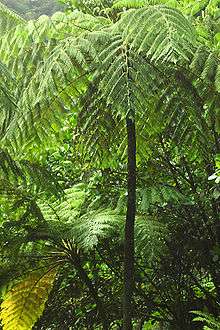Cyatheaceae
The Cyatheaceae are a family of tree ferns, the scaly tree ferns, one of eight families in the order Cyatheales in the Pteridophyte Phylogeny Group classification of 2016 (PPG I).[1] Alternatively, the family may defined much more broadly (Cyatheaceae sensu lato) as the only family in the Cyatheales, with the PPG I family treated as the subfamily Cyatheoideae.[2] The narrower circumscription is used in this article.
| Cyatheaceae | |
|---|---|
 | |
| Scientific classification | |
| Kingdom: | Plantae |
| Clade: | Tracheophytes |
| Class: | Polypodiopsida |
| Order: | Cyatheales |
| Family: | Cyatheaceae Kaulf. |
| Genera | |
| |
| Synonyms | |
| |
The family includes the world's tallest tree ferns, which reach heights up to 20 m. They are also very ancient plants, appearing in the fossil record in the late Jurassic, though the modern genera likely appeared in the Cenozoic. Cyatheaceae are the largest family of tree ferns, including about 640 species.[1] Cyatheaceae and Dicksoniaceae, together with Metaxyaceae and Cibotiaceae, are a monophyletic group and constitute the "core tree ferns". Cyatheaceae are leptosporangiate ferns, the most familiar group of monilophytes.[3]
The Cyatheaceae usually have a single, erect trunk-like rhizome (stem). Their fronds (leaves) are also very large, some of the largest in the plant kingdom. Some species have fronds reaching 3–4 m in length, and have a final crown width of some 6 m. The fronds are circinate before unfolding and usually pinnately or bipinnately compound, with deeply pinnately lobed leaflets. The large leaves are covered in scales and hairs, and bear sori (spore clusters) on their undersides.[4] The sori are often covered by a flap of tissue called an indusium, a useful characteristic for classifying the Cyatheaceae. Some indusia are cup-shaped (cyatheoid), while others are hood-shaped (hemitelioid), enclose the sorus (sphaeropteroid), or scaly. Like most ferns, members of the Cyatheaceae are homosporous. Cyatheaceae are found in both New and Old World tropical wet montane forests and cloud forests, with some species extending into south-temperate regions.[3] Most Cyatheaceae are terrestrial, with one sometimes being epiphytic and others having a creeping habit, but these are exceptions to the family norm.
Cyatheaceae can be distinguished from arborescent Dicksonia by the presence of scales, the position of the sori, and the morphology of sporangia and spores.[5] In the Cyatheaceae, the sori occur away from the margins of the pinnules, and are elongate or rounded.
Taxonomy
As of 2019, two different circumscriptions of the family Cyatheaceae are used, as summarized in the table below. In the Pteridophyte Phylogeny Group classification of 2016 (PPG I), the family is one of eight in the order Cyatheales, and has three genera.[1] In the classification of Christenhusz & Chase (2014), the family is the only one in the order Cytheales, the families of PPG I being reduced to subfamilies. It then has 13–14 genera.[2] The sensu stricto circumscription of PPG I is used here.
| PPG I (2016) | Christenhusz & Chase (2014) |
|---|---|
| Order Cyatheales A.B.Frank | Order Cyatheales A.B.Frank |
| Family Cyatheaceae Kaulf. | |
| Family Thyrsopteridaceae C.Presl | Subfamily Thyrsopteridoideae B.K.Nayar |
| Family Loxsomataceae C.Presl | Subfamily Loxsomatoideae Christenh. |
| Family Culcitaceae Pic.Serm | Subfamily Culcitoideae Christenh. |
| Family Plagiogyriaceae Bowe | Subfamily Plagiogyrioideae Christenh. |
| Family Cibotiaceae Korall | Subfamily Cibotioideae Nayer |
| Family Metaxyaceae Pic.Serm. | Subfamily Metaxyoideae B.K.Nayar |
| Family Dicksoniaceae M.R.Schomb. | Subfamily Dicksonioideae Link |
| Family Cyatheaceae Kaulf. | Subfamily Cyatheoideae Endl. |
Genera
Since the exact number of species is not known, classification of the Cyatheaceae s.s. has had a long and controversial history, and is still undergoing revision. Three tentative clades have been developed: Alsophila, Cyathea, and Sphaeropteris. These are frequently used as genus names. Cnemidaria, Trichopteris (or Trichipteris), and Nephelea (or Nephelia) have also been suggested as genera. Initially, indusium and scale morphology were used to organize the Cyatheaceae into taxonomic ranks. Most recently, plastid DNA has been used, suggesting the Cyatheaceae should be split into four clades: Sphaeropteris, Cyathea, Alsophila, and Gymnosphaera + A. capensis. As of 2007, it remained unclear which of these groups should be considered genera and which subgenera.[3]
The Pteridophyte Phylogeny Group classification of 2016 (PPG I) accepts three genera, placing the Gymnosphaera clade within Alsophila:[1]
- Alsophila R.Br., about 275 species
- Cyathea Sm., about 265 species
- Sphaeropteris Bernh., about 103 species
In 2018, Dong and Zuo provided names in Gymnosphaera for species they considered to belong in this genus.[6] Their hypothesis for the evolutionary relationship between these genera, based on their molecular phylogenetic study, is shown in the cladogram below.[6]
| Cyatheaceae |
| ||||||||||||||||||
References
- PPG I (2016). "A community-derived classification for extant lycophytes and ferns". Journal of Systematics and Evolution. 54 (6): 563–603. doi:10.1111/jse.12229.
- Christenhusz, Maarten J.M. & Chase, Mark W. (2014). "Trends and concepts in fern classification". Annals of Botany. 113 (9): 571–594. doi:10.1093/aob/mct299. PMC 3936591. PMID 24532607.
- Korall, Petra; Conant, David S.; Metzgar, Jordan S.; Schneider, Harald & Pryer, Kathleen M. (2007). "A molecular phylogeny of scaly tree ferns (Cyatheaceae)". American Journal of Botany. 94 (5): 873–886. doi:10.3732/ajb.94.5.873. Retrieved 2019-08-22.
- Judd, W.S., C.S. Campbell, E.A. Kellogg, P.F. Stevens, and M.J. Donoghue (Eds.) 2008. Plant Systematics: A Phylogenetic Approach, Third Edition. Sinauer Associates, Sunderland, Massachusetts, USA.
- Holttum, R.E. and P.J. Edwards. 1983. The tree-ferns of Mount Roraima and neighbouring areas of the Guayana highlands with comments on the family Cyatheaceae. Kew Bulletin 38(2): 155-188.
- Dong, Shi-Yong & Zuo, Zheng-Yu (2018). "On the Recognition of Gymnosphaera As a Distinct Genus in Cyatheaceae". Annals of the Missouri Botanical Garden. 103 (1): 1–23. doi:10.3417/2017049.
- Large, M.F. and J.E. Braggins Tree Ferns. Timber Press (2004). ISBN 0-88192-630-2
| Wikimedia Commons has media related to Cyatheaceae. |